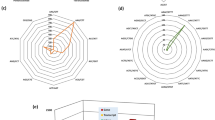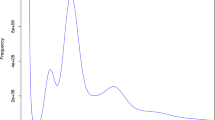Abstract
The veined rapa whelk (Rapana venosa) is an economically important gastropod in China, but is considered as an invasive species globally. Only a few studies have examined the R. venosa genome, a genomewide survey is necessary for improving our understanding of the genome structure and size of this organism. Microsatellite markers are powerful tools for characterizing germplasms, genetic diversity and kinship among individuals. The resultant data are applicable to breeding efforts in commercial aquaculture or for understanding invasion mechanisms. Here, we investigated the genome structure of R. venosa on an Illumina Hi-seq platform with \({\sim }92\times \) sequencing depth. We performed a K-mer analysis to estimate genome size, repeat sequences and heterozygosity. Clean reads were de novo assembled for the identification of simple-sequence repeat (SSR) loci that are suitable as markers. The estimated genome size of R. venosa was 2200.07 Mb, with a 1.41% heterozygosity rate and 67.04% repeats. We detected 5,477,450 simple-sequence repeats (SSRs), with 3,400,602 loci present as pure tandem repeats and 2,076,848 as compound motifs. We further selected and characterized 28 polymorphic markers in 78 individuals from Dandong, Laizhou, Weihai and Zhoushan in China. The range of alleles was 2–28 and the observed heterozygosity was 0.2857–0.8676. The data obtained from our genomic survey will aid the design of R. venosa whole-genome sequencing projects and advance the identification of SSR markers. Both these developments are valuable for further studies on ecological, evolutionary and genetic breeding in R. venosa.




Similar content being viewed by others
References
An J., Yu H., Yu R., Kong L. and Li Q. 2013 Isolation and characterization of 23 microsatellite loci in the veined rapa whelk (Rapana venosa). Conserv. Genet. Resour. 5, 1049–1051.
Bolger A. M., Lohse M. and Usadel B. 2014 Trimmomatic: a flexible trimmer for Illumina sequence data. Bioinformatics 30, 2114–2120.
Chandler E. A., McDowell J. R. and Graves J. E. 2008 Genetically monomorphic invasive populations of the rapa whelk, Rapana venosa. Mol. Ecol. 17, 4079–4091.
Drapkin E. 1963 Effect of Rapana bezoar Linne (Mollusca, Muricidae) on the Black Sea fauna. Dokl. Akad. Nauk. SSSR 151, 700–703.
Giberto D. A., Bremec C. S., Schejter L., Schiariti A., Mianzan H. and Acha E. M. 2006 The invasive rapa whelk Rapana venosa (Valenciennes 1846): status and potential ecological impacts in the Río de la Plata estuary, Argentina–Uruguay. J. Shellfish Res. 25, 919–924.
Gregory T. R. 2003 Genome size estimates for two important freshwater molluscs, the zebra mussel (Dreissena polymorpha) and the schistosomiasis vector snail (Biomphalaria glabrata). Genome 46, 841–844.
Hinegardner R. 1974 Cellular DNA content of the Mollusca. Comp. Biochem. Phys. A 47, 447–460.
Lanfranconi A., Hutton M., Brugnoli E. and Muniz P. 2009 New record of the alien mollusc Rapana venosa (Valenciennes 1846) in the Uruguayan coastal zone of Río de la Plata. Pan-Am. J. Aquat. Res. 4, 216–221.
Li R., Yu C., Li Y., Lam T. W., Yiu S. M., Kristiansen K. et al. 2009 SOAP2: an improved ultrafast tool for short read alignment. Bioinformatics 25, 1966–1967.
Li R., Zhu H., Ruan J., Qian W., Fang X., Shi Z. et al. 2010 De novo assembly of human genomes with massively parallel short read sequencing. Genome Res. 20, 265–272.
Liu J. X. and Avise J. C. 2011 High degree of multiple paternity in the viviparous Shiner perch, Cymatogaster aggregata, a fish with long-term female sperm storage. Mar. Biol. 158, 893–901.
Lowe A. J., Moule C., Trick M. and Edwards K. J. 2004 Efficient large-scale development of microsatellites for marker and mapping applications in Brassica crop species. Theor. Appl. Genet. 108, 1103–1112.
Lu M., An H. and Li L. 2016 Genome survey sequencing for the characterization of the genetic background of Rosa roxburghii Tratt and leaf ascorbate metabolism genes. PLoS One 11, e0147530.
Luo R., Liu B., Xie Y., Li Z., Huang W., Yuan J. et al. 2012 SOAPdenovo2: an empirically improved memory-efficient short-read de novo assembler. GigaScience 1, 18.
Mann R., Harding J. M. and Westcott E. 2006 Occurrence of imposex and seasonal patterns of gametogenesis in the invading veined rapa whelk Rapana venosa from Chesapeake Bay, USA. Mar. Ecol. Prog. Ser. 310, 129–138.
Morgante M. and Olivieri A. M. 1993 PCR-amplified microsatellites as markers in plant genetics. Plant J. 3, 175.
Morgante M., Hanafey M. and Powell W. 2002 Microsatellites are preferentially associated with nonrepetitive DNA in plant genomes. Nat. Genet. 30, 194–200.
Pascoe P. L., Jha A. N. and Dixon D. R. 2004 Variation of karyotype composition and genome size in some muricid gastropods from the northern hemisphere. J. Mollus. Stud. 70, 389–398.
Powell W., Morgante M., Andre C., Hanafey M., Vogel J., Tingey S. et al. 1996 The comparison of RFLP, RAPD, AFLP and SSR (microsatellite) markers for germplasm analysis. Mol. Breed. 2, 225–238.
R Core Team 2015 R: a language and environment for statistical computing. R foundation for statistical computing Vienna, Austria (http://www.R-project.org/).
Schell T., Feldmeyer B., Schmidt H., Greshake B., Tills O., Truebano M. et al. 2017 An annotated draft genome for Radix auricularia (Gastropoda, Mollusca). Genome Biol. Evol. 9, 585–592.
Sharma P. C., Grover A. and Kahl G. 2007 Mining microsatellites in eukaryotic genomes. Trends. Biotechnol. 25, 490–498.
Song H., Sun L.-Y., Yu Z.-L., Sun L.-N., Xue D.-X., Zhang T. et al. 2016a Metabolomic analysis of competent larvae and juvenile veined rapa whelks (Rapana venosa). Mar. Biol. 163, 1–8.
Song H., Wang H.-Y. and Zhang T. 2016b Comprehensive and quantitative proteomic analysis of metamorphosis-related proteins in the veined rapa whelk (Rapana venosa). Int. J. Mol. Sci. 17, 924.
Song H., Yu Z. L., Sun L. N., Gao Y., Zhang T. and Wang H. Y. 2016c De novo transcriptome sequencing and analysis of Rapana venosa from six different developmental stages using Hi-seq 2500. Comp. Biochem. Phys. D 17, 48–57.
Song H., Yu Z. L., Sun L. N., Xue D. X., Zhang T. and Wang H. Y. 2016d Transcriptomic analysis of differentially expressed genes during larval development of Rapana venosa by digital gene expression profiling. G3 Genes Genom. Genet. 6, 2181–2193.
Zhang H., Wei L., Miao H., Zhang T. and Wang C. 2012 Development and validation of genic-SSR markers in sesame by RNA-seq. BMC Genomics 13, 316.
Zhou W., Hu Y., Sui Z., Fu F., Wang J., Chang L. et al. 2013 Genome survey sequencing and genetic background characterization of Gracilariopsis lemaneiformis (Rhodophyta) based on next-generation sequencing. PLoS One 8, e69909.
Acknowledgements
This research was supported by the National Natural Science Foundation of China (grant no. 31572636), the earmarked fund for Modern Agro-industry Technology Research System (CARS-49), the Primary Research and Development Plan of Shandong Province (grant no. 2016ZDJS06A02), the industry leading talents project of taishan scholars (recipient: Tao Zhang), the NSFC–Shandong Joint Fund for Marine Science Research Centers (grant no. U1606404), the Strategic Priority Research Program of the Chinese Academy of Sciences (grant no. XDA11020703) and the Creative Team Project of the Laboratory for Marine Ecology and Environmental Science, Qingdao National Laboratory for Marine Science and Technology (no. LMEES-CTSP-2018-1). The funders had no role in study design, data collection and analysis, decision to publish or preparation of the manuscript.
Authors’ contributions
HS, TZ and HW conceived and designed the experiments. HS, JS and YZ performed the experiments. HS and MY analysed the data. TZ and HW contributed reagents, materials and analysis tools. HS wrote the paper.
Author information
Authors and Affiliations
Corresponding authors
Additional information
Corresponding editor: Silvia Garagna
HS, TZ and HW conceived and designed the experiments. HS, JS and YZ performed the experiments. HS and MY analysed the data. TZ and HW contributed reagents, materials and analysis tools. HS wrote the paper.
Rights and permissions
About this article
Cite this article
Song, H., Zhang, Yx., Yang, Mj. et al. Genome survey on invasive veined rapa whelk (Rapana venosa) and development of microsatellite loci on large scale. J Genet 97 (Suppl 1), 79–86 (2018). https://doi.org/10.1007/s12041-018-0975-z
Received:
Revised:
Accepted:
Published:
Issue Date:
DOI: https://doi.org/10.1007/s12041-018-0975-z




